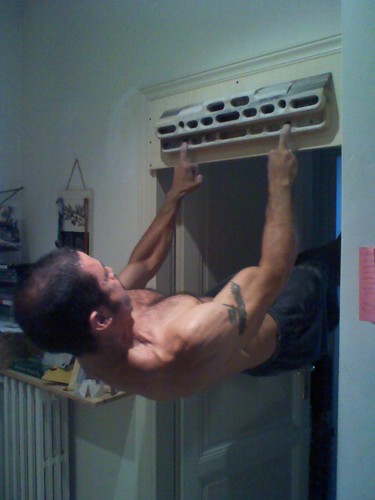 |
| Images from the cover and contents of The Rock Climber's Training Manual |
Over the past decade, Mark and Mike Anderson, brothers with
a lengthy and substantial climbing record across disciplines, have been
developing a training protocol called the Rock Prodigy Training Method. It’s
clearly having results. For example, Mark has emerged as a very strong climber, repeating various testpieces here in Colorado and in Utah and Oregon, as well
as doing 5.14 first ascents in places like Clear Creek Canyon and Shelf Road.
When their book The Rock Climber’s
Training Manual (referred to from here on out as TRCTM) came out I was very
interested to see what they would come up with. As a climbing book author
myself, I understand all too well the challenges inherent in gathering and
presenting what can be at times a very complex subject.
Fixed Pin Publishing very kindly sent me a copy of tTRCTM for review and I was immediately impressed by the richness and finish of the
book. The writing is very clear and the organization logical and coherent. The
basic premise of the book is that climbing improvement is a quantifiable
process and that a climber who wants to improve has to base that process on a
predictable plan with measurable goals and benchmarks. I think on this level
alone the book is very successful.
TRCTM is primarily intended for mid-level to advanced sport
climbers, an audience that is more likely to be interested in the kinds of
progression outlined in its pages. This is both its strength and weakness, at
least as far as bouldering is concerned. The front cover and indeed many of the
illustrations throughout the book are from the Red River Gorge and Smith Rock,
areas that emphasize continuous endurance climbing and in the case of many
routes in Smith, relatively low-angle technical small hold climbing. The Smith
Rock photos especially give the book a bit of a retro feel, since the
progression in high-end sport and bouldering in America has been on relatively steep power-endurance
routes such as at Rifle or problems like those found in RMNP or Hueco Tanks.
The gist of TRCTM is that following periodized cycles of
training will result in the greatest gains for your climbing, something that
has been at the heart of most training books in English since the
groundbreaking (and surprisingly current) Performance Rock Climbing by Dale
Goddard and Udo Neumann was published back in the 90s. Establishing levels of
strength, power and power endurance by means of the hangboard and campus board
along with regular trips to the gym are the heart of this training program.
Reviewing the basic outline of the training programs in the book, I found the
workout plans and tactics made sense, although I found the means by which one
finds the optimal weight at which to train on a fingerboard not entirely easy
to understand. I am terrible with charts and graphs, though. Everything is presented
in a relatively logical and analytical fashion and this is reassuring to anyone
embarking on a training plan. It’s a solid and comprehensive guide to getting
better, no question, especially for sport climbing.
For the specific pursuit of bouldering however I think this
book could stand some revision. Among other things I found curious was the
proposition that hangdogging and refining beta while working routes was easier and
more typical than in working boulder problems because the boulderer climbs from
the ground. In actuality boulderers often work problems close to the ground
with sit starts or steep features that allow stepping into crux moves or
sections quite easily. Boulderers are obsessive with refining beta to a degree
that might astonish some sport climbers unfamiliar with this aspect of the
sport. A closer look at the practices at the leading edge of bouldering today
would help iron out some of these issues.
In terms of training, bouldering is not just about adding
more intensity or weight, it is also about mastering very different body
positions, learning types of dynamic movement, coping with mental pressures, and developing effective tactics for safe successful attempts on problems, all in ways that will differ drastically from an enduro route in
the Red. Boulderers need to closely understand complex heelhooking, kneebars,
toehooks, and the overall intricacies of compression climbing. Dynamic movement,
though key in bouldering, is given relatively small space in the text as a
whole and not much in the (very short) section dedicated to bouldering. Of
course in bouldering dynamic climbing is critical to success on any limit
problem. The mental pressures of working out multiple limit moves that must be
linked flawlessly are similar to sport climbing but take on a qualitatively
different intensity in bouldering where success and failure can occur almost
arbitrarily. In other words, if training for climbing can be described as a
science, as TRCTM clearly intends, bouldering still feels more like an art where
criteria for advancement seem qualitative and subjective.
Is TRCTM desirable for boulderers? Yes and no. Given the
relatively short space dedicated to the sport in the book, it is clear that it’s
not primarily intended for bouldering, though ironically bouldering is seen as
critical in providing power for improving one’s sport-climbing level. However,
for any climber looking for a current and comprehensive understanding of the
basics of training theory as it applies to climbing overall, TRCTM is a great and relatively
inexpensive place to start. The effort and diligence of the authors is apparent
throughout and the publisher’s care in terms of layout and production is
clearly evident. But for bouldering training specifically, it has significant
limitations. The book on bouldering training hasn’t been written though I have been working on it a
bit. Watch this space.
Find out more at http://rockclimberstrainingmanual.com/
Mark's excellent blog https://lazyhclimbingclub.wordpress.com/

